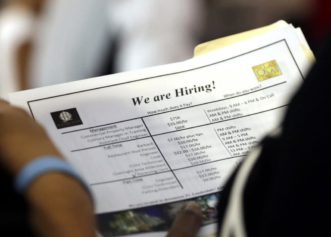Finding work is still a major headache in the black community. December overall job growth numbers in the U.S. indicate an increase of about 155,000 new jobs, with the unemployment rate still at 7.8 percent. While these figures are similar to previous months, the black unemployment rate saw a significant increase, signaling a challenge for President Barack Obama in his second term if he is going to make a difference for the black community.
The black jobless rate jumped from 13.2 percent in November to 14 percent in December, which is a big rise because the rate only includes people who are still actively looking for work.
Ever since the government began tracking unemployment data by race in 1972, the black unemployment rate has remained double the national rate.
In the African-American community, as in most others, many of the indicators of wellness, success and quality of life are connected to employment. When large numbers of black men and young blacks are unemployed, the standard of living for black families suffers dramatically, even in families where a female has a job.
When the leaders of the major black civil rights organizations, such as Rev. Al Sharpton of the National Action Network and Marc Morial of the National Urban League, met last month to craft a “black agenda” to present to President Obama, economic parity for African-Americans and increasing black employment were major items on the list.
“The plight of the African-American community underscores the urgency of our demand,” the leaders said in a joint statement. “The African-American community was disproportionately battered by the Great Recession, and has benefited the least from the fragile economic recovery. Unemployment remains unacceptably high; income inequality and the ever-widening wealth gap threaten to relegate the black community to perpetual underclass status. Those who wish to curtail investment education and career preparation further dim the prospects for upward mobility for our young people.”
The 155,000 jobs added in December were very close to the monthly average of 153,000 new jobs added during 2012. The economy has been steadily improving during the last two years of the Obama administration — the December 2011 jobless rate was 8.5 percent, in comparison to 7.8 percent for December 2012. But so many Americans lost work during the Great Recession that the number of jobs created will have to be a lot higher than 155,000 every month to really turn around the perception that the country is still limping along.
As the New York Times described it, the economy is “hiring fast enough to stay just ahead of population growth, but still too slow to make a sizable dent in the 12.2 million-person backlog of unemployed workers.”
The reaction to the numbers by the chairman of the President’s Council of Economic Advisers, Allan Krueger, was predictably optimistic: “While more work remains to be done, today’s employment report provides further evidence that the U.S. economy is continuing to heal from the wounds inflicted by the worst downturn since the Great Depression. It is critical that we continue the policies that are building an economy that works for the middle class as we dig our way out of the deep hole that was caused by the severe recession that began in December 2007.”
And the response from House Speaker John Boehner was predictably negative: “Too many Americans are still out of work and Washington has too much debt. Our oversized and overspent federal government is a drag on economic growth and job creation, and has burdened every American with a $50,000 share of its debt, and rising. This is the year we need to work together to solve these problems. In the coming months, the House will pass real spending cuts, meaningful reforms of the entitlement programs that are driving us deeper into debt, and a fairer, cleaner tax code. These are the keys to unleashing robust job growth and securing a better future for our children.”

